What are Pastelles?
Pastelles are a popular favorite amongst Trinbagonians around Christmas time. I don’t know why we wait all year to make these (most likely the work involved). According to Wikipedia, it is believed that the pastelles were introduced by Spanish colonizers who ruled the island between the late 15th and early 18th centuries.
This comfort food should be in your freezer year-round to enjoy as a snack.
It’s made up of two components, the cornflour mix and a savory filling such as beef, chicken, pork, or seafood cooked with raisins, capers, olives and other Caribbean flavors. The filing of your choice is enclosed within the soft, melt-in-your-mouth corn flour(if done right) and wrapped in banana leaves.
What type of filling can be used?
I’ve made pastelles with chicken, turkey, ground beef, and bison, and I’m beyond excited to try many variations in the future. Pastelles’ sweeter counterpart, ‘paime’, does not contain any filling and is made with cornmeal, coconut, and raisins—an optional ingredient.
This pastelle recipe has a wonderful balance of flavors—sweet, savory, spicy (optional), and a hint of salty from the olives and capers. If you don’t like raisins, olive or capers, I would recommend that you not eliminate those ingredients entirely but chop them fine. This way you get the celebration of flavors without the experience of biting into anyone.
My Secret Method
I spread the mix with the back of a spoon in a circle on the banana leaf, placed the filling along the diameter, and wrapped it. The oblong pastelle ‘pie” is then tied with a string (I didn’t do it here because I couldn’t find mine!). Once wrapped, the pastelles can either be cooked in boiling water, steamed or frozen for later use(I prefer steaming so that liquid or water does not seep into the wrapped leaves).
What are Pastelles referred to as around the world?
Many regions of the world have their variation of banana leaf-wrapped snack/meal and there are many versions in the Caribbean, Central, South, and Latin America. Pastelle-making is rooted in tradition and usually involves many family members assisting in the process. My Jamaican co-worker talks about dukunu (blue drawers which has a banana-sweet potato filling. In the Dominican Republic, it is known as tamal or guanimos, and is made with cornflour stuffed with ground meat. Puerto Ricans use mashed green plantains and root vegetables to make theirs. My Venezuelan friend described their version as hayaca or hallaca, a corn dough stuffed with similar meat variations and ingredients—sometimes using hard fowl. The thought of that gets me excited.
Where can I find banana leaf?
You can find frozen banana leaves in your supermarket in the Caribbean section. These leaves are already supple, which does not require heating over an open flame or immersing in hot water. If your supermarket does not have such a section, ask the store manager—or move. That’s all. You may also get technical and use a pastelle press.
Two methods of making the dough
In my video below, I show you the traditional method plus my shortcut method of using a paste–no pastelle press is required. In this method, you can skip the step of making balls, then pressing into a circle. I find that a little extra liquid in the corn flour mixture results in a more tender pastelle without the need to add a pound of butter. At the end of the day and the holidays, my motto is still all things in moderation(I bet you don’t believe me).
These pastelles are already flavorful and do not require any condiments, but I won’t hold it against you if you drizzle it with a little Caribbean pepper sauce.
Testimony from a bona fide Trini: “I’m not mamguying you, but this is better than some they sell in Trinidad, this is real good girl.”
TRINI PASTELLES
Equipment
- Equipment
- Large stock pot or wide saucepan.
- Banana Leaf, cut into rectangles 10 x 9 inches
- Foil or parchment paper, cut into rectangles, 12 x 8 inches
- Twine (not required if using foil)
Ingredients
Make Dough
- 2 cups fine yellow corn flour I used Promasa
- 1 ½ teaspoons Himalayan salt
- 2 tablespoons brown sugar
- 4 tablespoons butter salted, melted
- 1 ½ cups water 3 cups for the paste method
For the meat filling
- 1 lb minced meat beef, lamb, pork, chicken
- ½ large sweet onion finely chopped
- 6 cloves garlic
- 1/2 carrot small
- ½ large red sweet pepper bell pepper, finely chopped
- 20 olives finely diced
- 1/2 cup raisins chopped
- 2 tablespoons capers drained and finely diced
- 1 ½ tsp salt
- 4 Scallions chopped
- 2-4 Caribbean pimento peppers seasoning peppers and/or hot peppers (habanero or scotch bonnet), diced, optional
- 2 tablespoons green seasoning
- 2 tablespoons ketchup or tomato paste
- 1 tsp dried oregano
- 1 tsp roasted cumin
- Salt to taste
Instructions
To cook meat:
- Add the onion, garlic, carrot, bell pepper, (hot pepper, if using), olives, scallions and raisins to the bowl of a food processor and pulse until smooth or desired texture to save on prep time or finely chop by hand.
- Heat oil in a heavy bottomed pot or dutch oven over medium heat.
- Add meat and cook until brown. If it's dry, especially if you used lean meat, add 1-2 tablespoons oil.
- Add minced ingredients—onion, garlic, carrot, bell pepper, hot pepper, pimento pepper, if using, olives, capers, scallion, ketchup or tomato paste, oregano, cumin, salt, black pepper, cook for 5 minutes, then add 1 cup water, bring to a boil, reduce heat to low and cook about 20 mins or until the meat is tender and flavorful and most of the liquid has evaporated. Taste and add more salt and pepper or seasoning if required.
Dough:
- Place corn flour in a medium bowl. Mix in salt, sugar and melted butter. Gradually pour in warm water into corn mixture and mix thoroughly until the excess liquid is absorbed. Form into smooth balls and keep covered until ready to use.
- If using the runny paste method, add enough water until the dough forms a smooth paste, about 3 cups. Amount of liquid will vary depending on the brand of corn flour.
- If using the paste method, skip this step. Make into 8 balls, about 2 ozs each. You can certainly make them larger. I demonstrated 4 oz on the video. Place on an oiled tray and cover with a damp cloth, especially if you are making a large quantity.
To assemble and cook:
- Cut parchment paper or foil 12 x 9 inches.
- To prepare banana leaves: Wilt in boiling water or over an open flame only for a few seconds. Dry, wipe leaves and cut into rectangles 10 inches x 9 inches. Frozen banana leaves do not require any preparation except wiping with a paper or kitchen towel.
- Place parchment paper or foil on counter, then place the banana leaf in the center.
- Oil banana leaf liberally. Place dough ball into center of the banana leaf. Press to flatten using your fingers or a pastelle press. Do not press out too thin. If using the paste method, place 2-3 heaping tablespoons corn dough mixture into the center of the banana leaf. Flatten and spread out the dough evenly in a circle using the back of a spoon.
- Place a heaping 2-3 tablespoons of filling vertically along the center of the dough. Using the leaf, bring half of the dough towards the center of the filling. Fold over the other half to cover the second half of the filling. Fold the bottom up and the top down to make a packet. Now fold the leaf around the filled dough to make a parcel. Fold and tie the parchment paper around the folded leaf with a kitchen string. If using foil tightly fold the ends of the foil to seal. Repeat with the remaining dough and filling.
- Meanwhile, bring a few inches of water in a stock pan or wide sauté pan to a boil. Put wrapped pastelles into pot, cover, reduce heat to low and steam for 60-90 minutes. Drain immediately and place on a flat surface as they retain the shape when they become cold. Check occasionally to ensure that all the water has not evaporated –or else they will burn. Enjoy hot or warm.



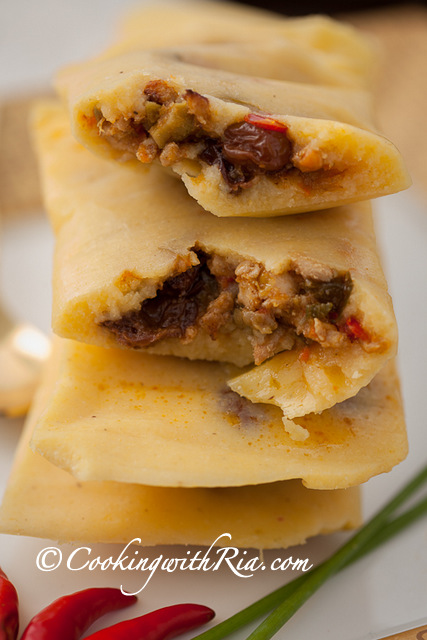
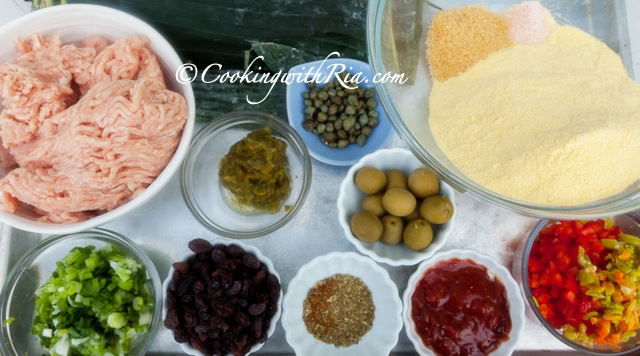
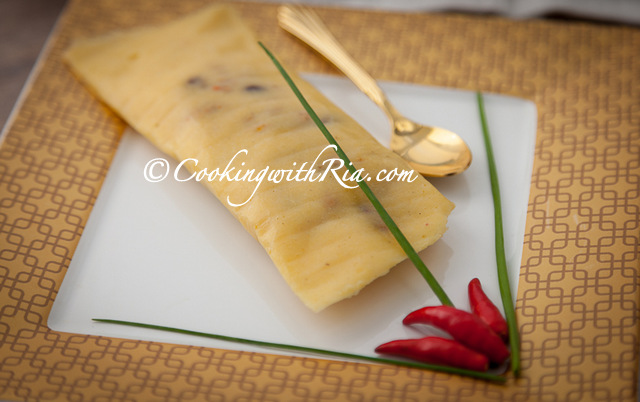
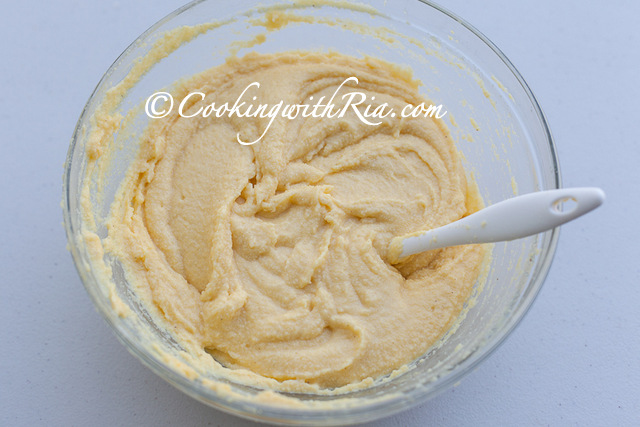
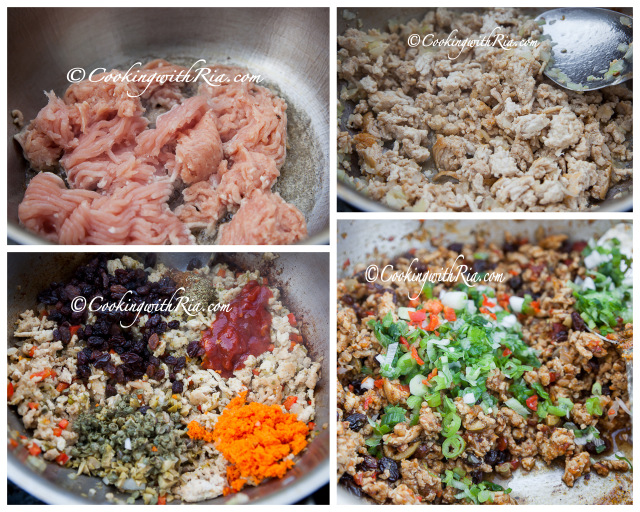
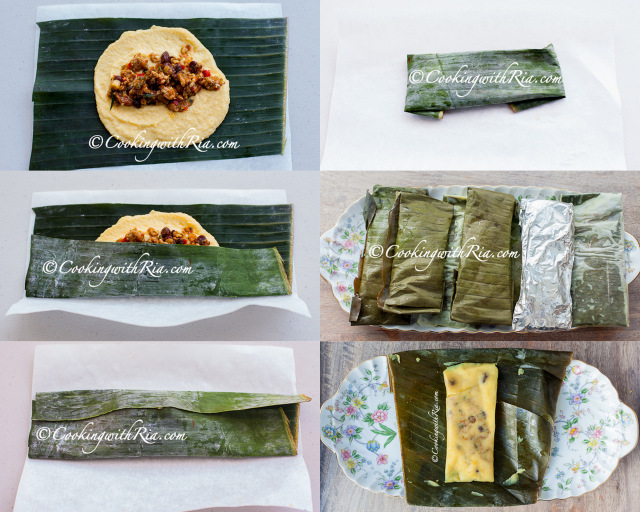
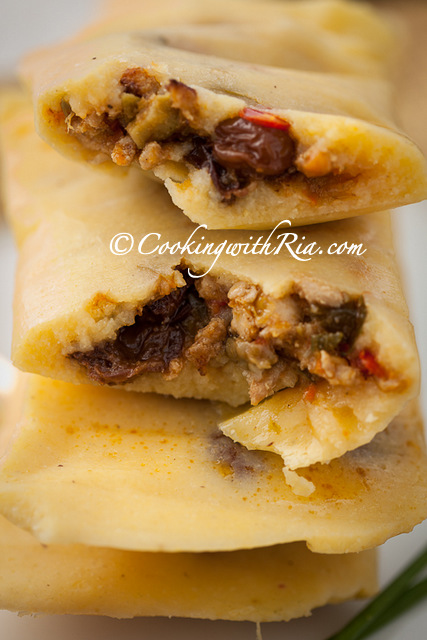

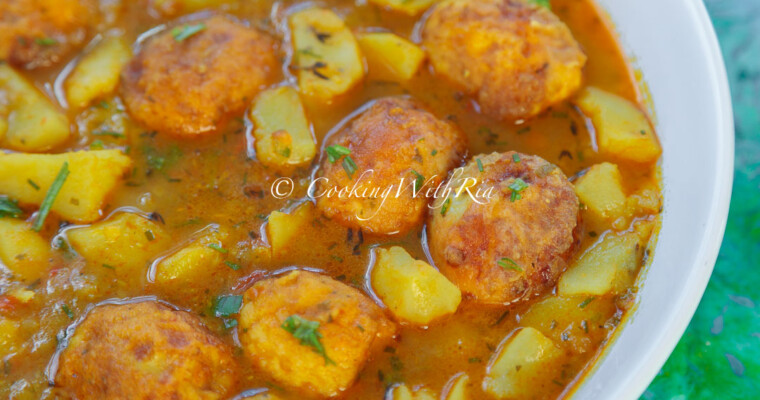
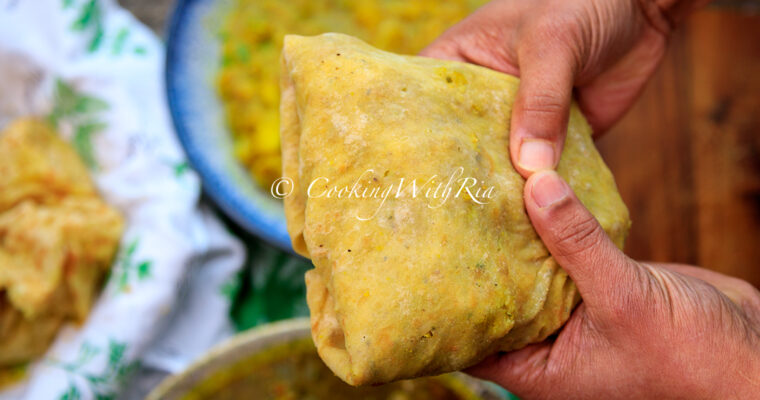

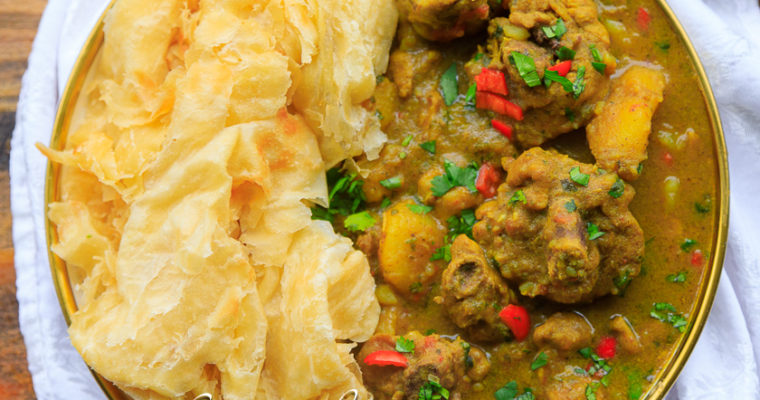


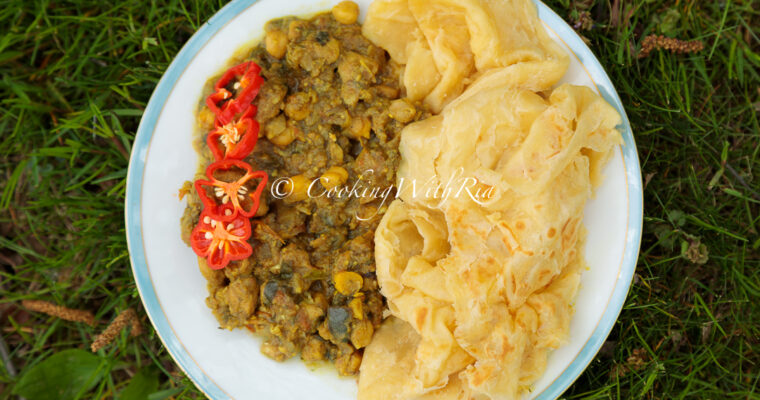
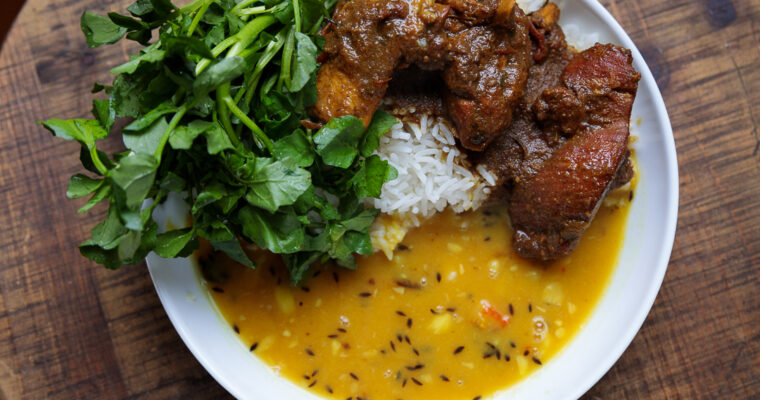
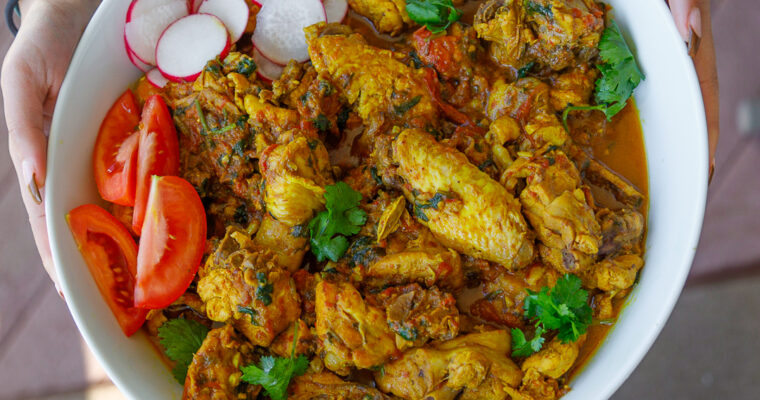
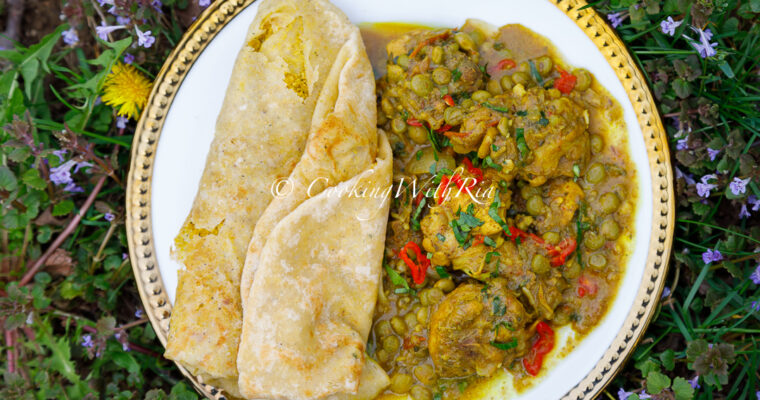


Delicious, very tasty – followed the fast method.
It was a breeze.
I’ve read a couple of your recipes and you make it sound so simple it’s a lot of love & needless the effort & work
Thank you been wanting to make this since last year..
3rd year making pastelles and once again a smash hit ⭐️⭐️⭐️⭐️⭐️